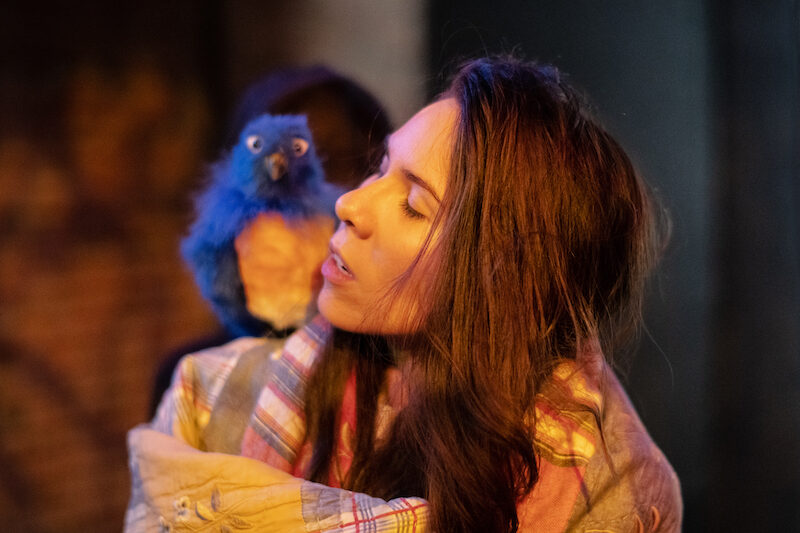The Female Gothic and Puppetry at We Go Mad
Review of We Go Mad at 18th and Union.
Written by TeenTix Newsroom Writer Olivia Villa and edited by Teen Editor Kendall Kieras.

With the recent rise of box-office-breaking horror movies, it seems the genre is experiencing a renaissance of sorts. One subgenre of horror, however, that has consistently remained in pop culture’s periphery is gothic romance. For theater fans of the genre, it’s time to get excited. Here to marry gothic romance themes to those of 70s horror and ghost stories is Amy Escobar’s play We Go Mad, which had its world premiere September 20, 2019.
The play centers an unnamed woman who inherits a looming estate (and possibly much more) from her great-grandmother. Escobar draws us into a dark world of fairy royalty, intergenerational trauma, levitation, body dysphoria as a haunted house, and break-ups that break records for their awfulness. But while We Go Mad finds a saving grace in its passion for the mystery and the supernatural sublime, it faces some unavoidable issues with integrating different tones.
The backstory itself is a dizzyingly intricate puzzle—which is for the better, as long as you can keep up. We Go Mad includes fascinating lore that begs the audience to return a second time after piecing it all together. The different narrative frames, at first seemingly disjointed, come together more fittingly by the end. The ambiguous elements work. Overall, it adds to the aesthetic.
Speaking of the aesthetic, the effects in We Go Mad are generally magnificent, though the modified bunraku (a kind of puppetry where the black-clad puppeteers remains visible to directly manipulate movement) has messy moments. The detail in the shadow puppetry has a whimsical, campy, graphic novel quality. Rendered black and white, the hair of the protagonist is cascading and luxurious; the water drops in the shower are looming and cyclical. The details set up the following action to be literally shudder-inducing. Also memorable are the large scale environments that the shadow puppetry on occasion portrays. It’s hard to imagine how the play would have captured the same magical sublime without it. The modified bunraku alternately works or doesn’t in various scenes. There are moments of corniness, like when shaking skeleton hands are overly maudlin and break the illusion. Nonetheless, the shadow puppeteers generally are excellently coordinated, especially in their dancing. The costuming melts into the background, and the cloth masks render each actor timelessly mysterious. When used, their voices are wispy and dark, and their undulating movements make good use of the space onstage. They do work with flying birds, for example, which integrates these elements well.
The problem with the We Go Mad starts with the conflicting tones. The play features too many sources of inspiration and a protagonist who apparently has two distinct personalities (quirky and feral) that cannot acknowledge each other. As a result, maintaining a cohesive image throughout the play is tricky. The transitions come across as clunky and paced awkwardly. Sometimes, they run too long, as in the case of a montage involving drawn-out bird symbolism. But more often, it’s whiplash-inducing, resulting in unfortunate unintentional humor in darker scenes.
If the writers leaned more into their social commentary, deepening parallels between the female experience and the protagonist’s visions, the transitions might not have felt so forced. The narrative has been informed by the experiences of its creators, but only looking up background information on the creative process does any message come through. The idea that a woman’s body is like a house locked up with secrets, compartmentalized and haunted even to her, is intriguing. Same goes for a portrayal of intergenerational trauma as insidious and lurking. It would have been more compelling to explore it further, especially through the protagonist’s relationships with others. Unfortunately, the other characters don’t foil her easily. They also stay as far away as possible from the protagonist’s state of mind as a conversation topic. Consequently, the protagonist doesn’t get the opportunity to open up very often. When she can, though, it works.
One of the best scenes in the play, for example, is one where the protagonist has a hypothetical heart-to-heart with her absent mother. I wish we could see more of that tenderness with which Escobar plays her character; it’s creepily endearing. The entire scene is a graceful, eerie delight, and weds neatly to the more contemporary music. That dress, that movement, that acting! It’s the most gothic romance way to commemorate your mother since Mary Shelley.
Honestly, I really wanted to love this play because the bones of social commentary are there and the care put into the world-building and aesthetics should be a big draw. It could conceivably be a play that garners a fawning fanbase over the years. Unfortunately, it fails to significantly get inside the mind of its protagonist, disrupting the transition from her ordinary world to the special one of madness. While it’s fun to watch, its lost potential is ultimately more memorable.
Lead Photo Credit: Amy Escobar's We Go Mad at 18th and Union. Photo by Truman Buffet.
The TeenTix Newsroom is a group of teen writers led by the Teen Editorial Staff. For each review, Newsroom writers work individually with a teen editor to polish their writing for publication. The Teen Editorial Staff is made up of 6 teens who curate the review portion of the TeenTix blog. More information about the Teen Editorial Staff can be found HERE.
The TeenTix Press Corps promotes critical thinking, communication, and information literacy through criticism and journalism practice for teens. For more information about the Press Corps program see HERE.


